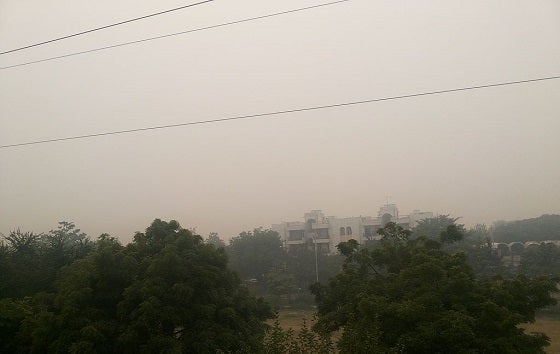Summary
Delhi has been shrouded in a thick dark haze over the past week, with harsh consequences for public health. Why does this phenomenon recur every year? What are the consequences?
Over the past several years, during late October and early November, the National Capital Region (NCR) of Delhi has been shrouded in a thick, dark haze, with an acrid smell and recorded particulate matter rising to 40 times beyond that deemed safe by the World Health Organisation (WHO). The volume of toxins inhaled on the worst days is equivalent to smoking 40 to 50 cigarettes. Home to 45 million people, during this period the NCR has been described as a ‘gas chamber,’ or a ‘post-apocalyptic scene’.
The challenge of poor air quality is not confined to India. Nine of ten people on the planet breathe polluted air, caused by industrialisation, rapid urbanisation, power generation plants, and, in developing countries, crop burning. The consequences of burning undergrowth for clearing land for cultivation in Kalimantan, Sumatra and Chiang Mai are well known. However, the scale of the problem in India today has grown to crisis levels. Fifteen of the twenty most polluted cities in the world are in India, with the capital, New Delhi, and its suburbs rated amongst the worst. Why is the problem so acute in India? What are the consequences of atmospheric pollution? And what can the government do to mitigate the problem?
Causes
Delhi suffers from poor air quality that seldom improves beyond ‘moderate’ throughout the year. Vehicular and industrial emissions and dust from construction and dry, exposed soil, account for air pollution during ‘normal’ times, with up to six times the particulate matter
considered safe by the WHO. The readings rise sharply into the unhealthy and hazardous range around Diwali, the festival of lights, when firecrackers are lit across the region.
At the same time, the lighting of stubble from the rice harvest in the North-western states of Punjab and Haryana severely compounds the problem. Rice is harvested towards the end of October. Four weeks later, farmers sow the wheat crop. To cut down costs, instead of
uprooting, farmers set the stubble alight. The smoke from the fires spreads, enveloping the region, including Delhi, in a cloud of smoke. A seasonal weather pattern during this period, when the air is humid and winds die down, ensures that the haze remains suspended over the
NCR for days. The readings for PM2.5, an index measuring the smallest particulate matter in the air that can enter the lungs and cause permanent damage, exceed the WHO recommended normal level by a magnitude of 40, placing the entire population at risk.
Consequences
The repercussions of air pollution are severe. Aside from respiratory and cardiovascular problems, haze is also linked to Dementia, Alzheimer’s and other mental health problems. The young are particularly vulnerable as their lungs are developing and children breathe faster than adults. Their low height puts them closer to the ground where the levels of toxins are higher. A recent finding estimates that 50 per cent of children in Delhi have suffered permanent lung damage. Weaker lungs also render the old susceptible. A 2013 study by The World Bank computed the labour and welfare loss due to air pollution in India at 8.5 per cent of GDP. Pollution is the second most serious risk factor after malnutrition, resulting in the death of over 1.24 million below the age of 70 in 2017, with life expectancy reduced by 1.2 years.
Policy Response
The government has acknowledged the perils of air pollution and taken steps to check the growth of particulate matter in the atmosphere. Emissions from poor households from burning wood and cow dung fell following the supply of liquefied petroleum gas to the poor. Coal-fired
power plants around Delhi have been shuttered, and the courts banned the sale of firecrackers, a measure that is easily circumvented. Checks on vehicular emissions are negated by the unrelenting growth of car ownership and the lack of an effective mass transit system. The Delhi government limits the entry of trucks into the city, banned construction during the period and mandated cars with odd and even numbers drive on alternative days. The state governments banned crop-burning and announced fines on violators but thus far refrained from taking decisive steps to implement it due to fears of a backlash from nearly two million small farmers at the electoral box.
These measures fail to address the problem effectively. Despite the critical situation, the political will to take on powerful vested interests, including farmers, small firms, construction companies and the automotive sector seemed to be lacking. The public at large, has been unable to effectively channel its frustration at the lack of decisive action. On November 6, 2019, the Supreme Court stepped in with orders for the state and union governments to stop shifting blame and work towards a coordinated solution. The growing public anger, intervention by the courts, and the sense of urgency amongst policymakers may finally catalyse moves to address this problem in a sustainable manner. It is instructive that China accomplished significant reductions in air pollution not so long ago.
As is the case with fires in Indonesia, aside from small farmers, air pollution in Delhi is generated mainly by the actions of the wealthy and the middle class, and the costs are borne primarily by the young, the poor and the infirm. The consequences for the quality of life and health in Delhi and its vicinity are devastating. Policymakers do not have the luxury of time in dealing with the issue.
….
Dr Dipinder S Randhawa is a Senior Research Fellow at the Institute of South Asian Studies (ISAS) at the National University of Singapore (NUS). He can be reached at isasdsr@nus.edu.sg. The author bears full responsibility for the
facts cited and opinions expressed in this paper.
-
 More From :
More From :
-
 Tags :
Tags :
-
 Download PDF
Download PDF



